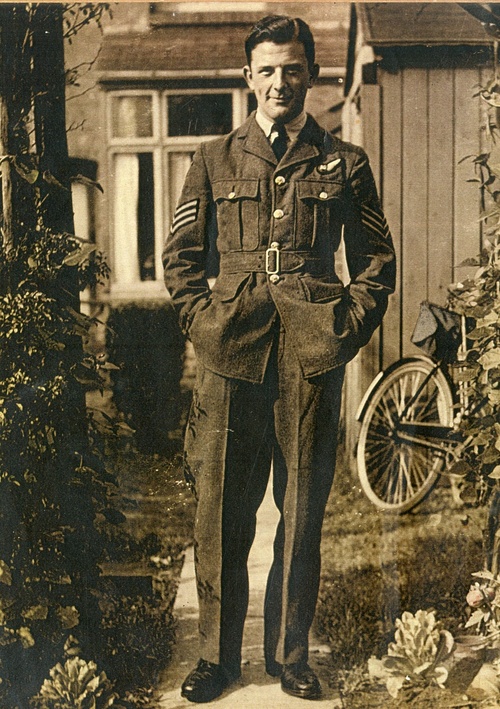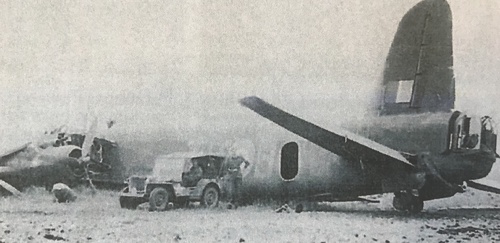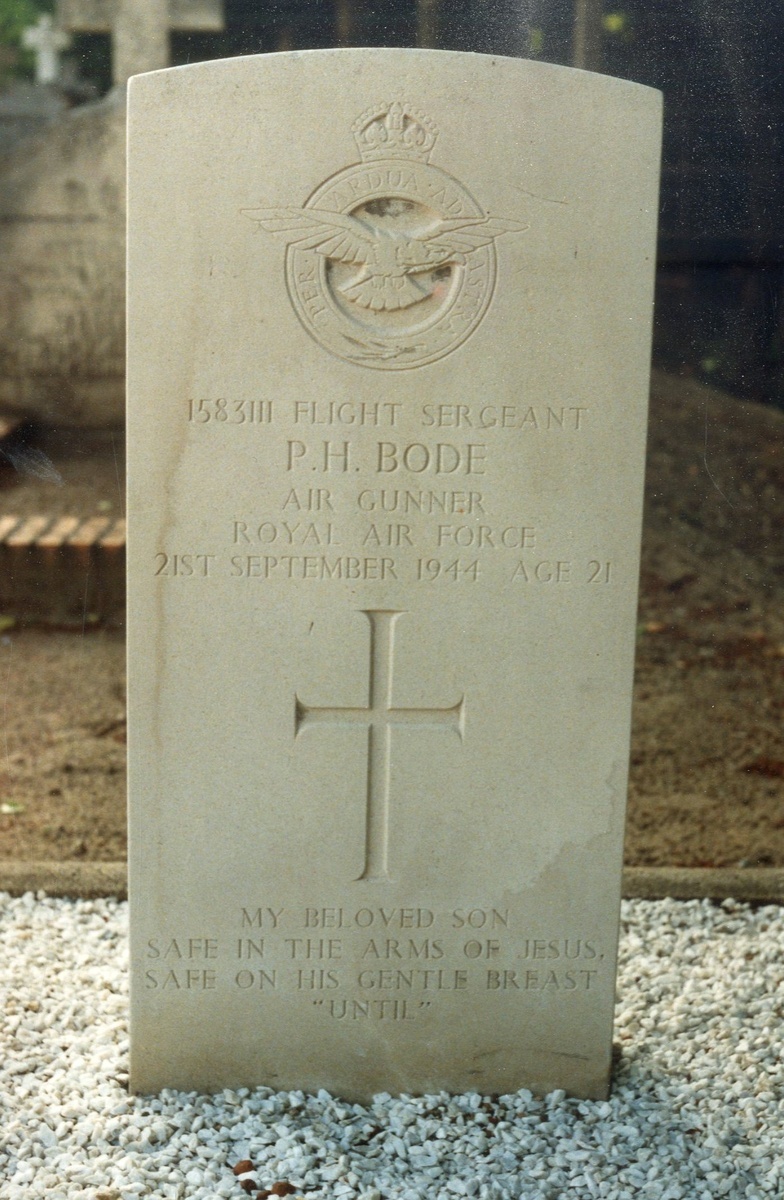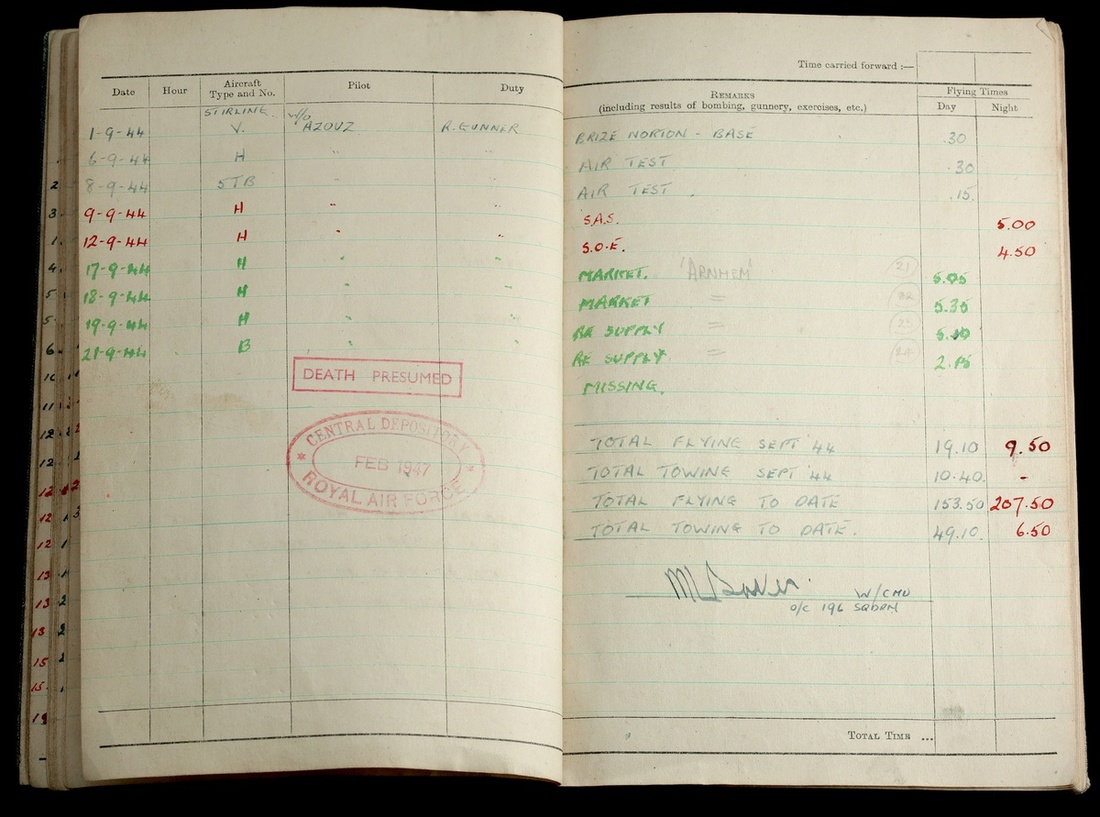Auction: 18001 - Orders, Decorations and Medals
Lot: 47
'Then they got nasty … they raked us. God they gave us a hammering … where had all the dust come from? I can see it now, it was just like a fog in the aircraft, dust and muck … I remember we were diving and I was suspended in the fuselage, just standing on nothing … '
Sergeant 'Bert' Turner, a Flight Engineer of No. 196 Squadron, describes the dying throes of Stirling LJ810 ZO-B: severely mauled by Me. 109s over Arnhem, the aircraft was gallantly defended by his Rear Gunner, Flight Sergeant Peter Bode, who managed to down one of the 109s before being killed in his turret by point-blank cannon fire
An outstanding Second World War 'special duties' and Arnhem campaign group of three awarded to Flight Sergeant P. H. Bode, Royal Air Force Volunteer Reserve
His tour of operations as a Rear Gunner in Stirlings of No. 196 Squadron was exceptional in every respect, incorporating as it did numerous 'special duties' operations on behalf of S.O.E. and the S.A.S.: on one such sortie to the Brest peninsula his aircraft's starboard outer engine was blown clean off by flak but pilot and crew continued to their allotted D.Z.
Subsequently heavily engaged in "Market Garden" - they made three successive trips to Arnhem on the 17th, 18th and 19th September 1944 and endured further flak damage - pilot and crew were due for a rest
Fate however intervened and they were ordered to carry out one more re-supply sortie on the 21st. A sitting duck after taking serious flak damage over the D.Z., their Stirling was jumped by 109s and shot down, but not before the gallant Bode had accounted for one of their number: he was killed by retaliatory cannon fire in his rear turret and his pilot likewise shot on the end of his parachute after baling out
1939-45 Star; France and Germany Star; War Medal 1939-45, extremely fine (3)
Peter Harold Bode commenced training as an Air Gunner in June 1943 and, having qualified, was posted to No. 90 Squadron, a Stirling unit. He flew his first operational sorties - a spate of gardening trips - in February 1944 but in the following month he transferred to No. 196 Squadron at Keevil.
No. 196 Squadron - S.O.E. special duties
His new squadron had just converted to 'special duties' operations on behalf of S.O.E. and Bode undertook his first such mission - to the south of France - on the night of the 30th, when he flews as Rear Gunner in Flight Sergeant Oliver's crew. In the following month, however, he transferred to Flight Sergeant Mark Azouz's crew, with whom he would remain employed for the rest of his operational career. Their first S.O.E. operation - another outing to the south of France - was flown on the night of 29-30 April 1944.
Meanwhile, the pending Normandy landings witnessed No. 196 Squadron preparing for vital airborne operations in support of Operation "Tonga". On that occasion Bode and his crew delivered 20 paratroops to their D.Z. on the night of 5-6 June and, a few days later, 17 members of the S.A.S. to an unknown destination.
July witnessed Bode and his crew undertake three further S.O.E. missions to the south of France, sorties that were quickly followed by 'a special mission to Brest' to the "Horace 8" circuit on the night of 2-3 August. On that occasion their Stirling was laden with 24 containers and one 'packet', all of which were delivered to their D.Z. under remarkable circumstances. The recommendation for the recently promoted Warrant Officer Mark Azouz's immediate D.F.C. takes up the story:
'On the night of 2 August 1944, Warrant Officer Azouz was detailed for an S.O.E. operation in the Brest peninsula. On his final run up to the D.Z. his aircraft was hit by flak. The propeller and reduction gear of the starboard outer engine were blown away, the starboard inner propeller and pipe lines were hit and both ailerons damaged. This N.C.O. carried on with the mission and successfully completed the operation.
He returned after dropping on two engines and one failing engine. On reaching base the weather conditions necessitated his being directed to Colerne where he carried out a successful landing without the aircraft being further damaged.
By his skill, courage and consistent devotion to duty, he saved his aircraft and the lives of his crew. Recommended for an immediate D.F.C.'
Two nights later, pilot and crew carried out another special mission to Brittany, followed by a trip to the Geneva area on the 9th, when 20 containers and two 'packages' were delivered to their destination - Bode's log book notes 'packages' of an S.A.S. nature. Two similar sorties were flown on the 24th and 26th, followed by others to Liege on the 28th and a 'major effort' - destination unknown - on the 31st.
September saw Bode's crew detailed to another S.A.S. operation on the 9th, destination Belfort in France, with 24 containers and four 'packages', in addition to an S.O.E. operation to Holland on the 12th, with 18 containers and five 'packages'.
Arnhem - four trips - journey's end
The commencement of Operation "Market Garden" now intervened, 196's Stirlings bearing much of the brunt of successive re-supply operations. Having taken part in the first airdrop on the 17th, Bode and his crew returned to Arnhem on the 18th, towing a re-supply Horsa. On the following day they delivered 24 containers and four panniers, their Stirling being shot-up by flak over the D.Z. They were now due for a rest but owing to horrendous squadron losses they were asked to undertake one further re-supply mission.
And so to the tragic events of the 21st, when the gallant Bode defended his aircraft to the bitter end. He and his crew were running late behind their fellow aircrew, having had to exchange from a faulty aircraft to a reserve aircraft on take-off.
'Bert' Turner, the Flight Engineer, takes up the story:
'We climbed into the spare - L1810 ZO-B - and we were 20-25 minutes late. Off we went, we cut every corner we could think of, but were still late over the target and just as we were coming in the other lads were coming out; they had taken a battering. There were Stirlings lying all over the place but the skipper put the nose down and in we went. We took a battering, we dropped our supplies and four big panniers - we had two airborne bods with us dropping those panniers. Mac McQuiggan was down the back supervising the panniers going out and I was 'second dickie' with the skipper. We turned round and we came out of it, and we were a mess … We wouldn't get home, that was no question and the skipper asked Ginger for a course to Brussels. I had got a piece of flak of some kind in my ankle but otherwise there was nothing wrong with me. Everybody else was all right and everybody sounded off … '
Turner continues:
'I stuck my head out of the astrodome and then turned to the skipper and said, "We're all right now, skipper, there is our escort." I thought them to be Tempests and to this day I don't know how I made the mistake … they turned out to be Fw. 190s [In fact Me. 109s]. They made a Vic attack from astern. Whether they were sprog pilots I will never know. We couln't corkscrew or anything. We just had to sit there, take it or get out … Pete [Bode] opened up and he got the man at the point and they got nasty … they raked us. God they gave us a hammering … where had all the dust come from? I can see it now, it was just like a fog in the aircraft, dust and muck … I remember we were diving and I was suspended in the fuselage, just standing on nothing.
Then the skipper gave the order to get out. As I went down the back I checked on Pete [Bode] but he was dead. McQuiggan didn't want to jump because he thought his parachute wouldn't open because of the Elsanal fluid - which had showered over him after crew's chemical toilet was blown off its mount by flak - but he had to go ands that was it, out he went and I followed him through the parachute exit. Just as I went out I remember the chain broke that held the exit door up and it slammed behind me. Luckily the two of us got out all right from the back and Ginger jumped from the front exit. I opened my parachute and a voice shouted to me: "Move over in the sky, I haven't got enough room!" It was Ginger and we shook hands on the way down!'
The pilot, Mark Azouz, has kept the aircraft on a southerly course, giving his crew and the two R.A.S.C. despatchers the chance to bale out. He jumped last but was shot on the end of his parachute by the 109s.
The stricken aircraft, which Azouz had left on 'George' the automatic pilot, glided down onto farmland near Niftrik, an eye-witness seeing its propellers plough up the ground - one of the wings hit a row of pollard-willows and sheared off the aircraft, so too the engines which rolled on. The wreckage came to a standstill not far from the front of Schebbelaar Farmhouse. Inside the rear turret - shattered by cannon fire - lay Bode's body.
The remainder of the crew, including the two R.A.S.C. air despatchers, made successful descents; Azouz's Flying Log Book - and his medals -is held in the Jewish Servicemen's Museum, London.
The son of James and Rose Elizabeth Bode of Ward End, Birmingham, Peter Bode was 21 years of age. Originally buried in a field at Niftrik, his remains were moved to in Wijchen Roman Catholic Cemetery after the war, where he rests alongside another R.A.F. Arnhem casualty, Flight Sergeant W. H. Skewes.
Sold with the recipient's original R.A.F. Navigator's, Air Bomber's and Air Gunner's Flying Log Book (Form 1767 type), covering the period June 1943 to September 1944, with red ink R.A.F. Central Depository and 'Death Presumed' stamps, together with post-war letters from immediate family; also sold with a quantity of copied research, including an article from Flypast magazine - 'Stirling Service over Arnhem' - upon which the latter part of the above footnote has been based.
Subject to 20% VAT on Buyer’s Premium. For more information please view Terms and Conditions for Buyers.
Sold for
£800













